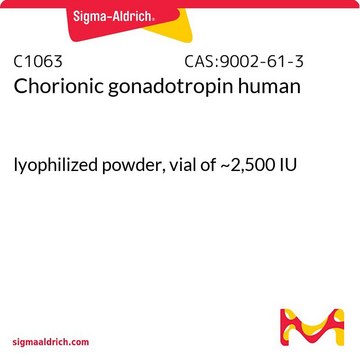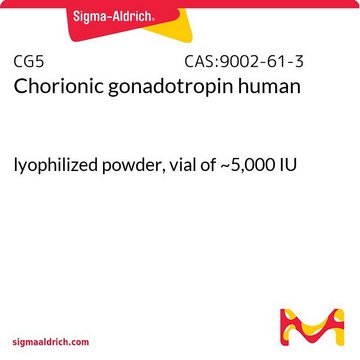C8554
Chorionic gonadotropin human
lyophilized powder, suitable for mouse embryo cell culture
Synonym(s):
Choriogonin, HCG
Sign Into View Organizational & Contract Pricing
All Photos(1)
About This Item
biological source:
human urine
form:
lyophilized powder
Recommended Products
biological source
human urine
Quality Level
sterility
aseptically processed
form
lyophilized powder
potency
≥5,000 I.U. per mg
mol wt
37.9 kDa
apparent mol wt 37.9 kDa by SDS-PAGE
drug control
Home Office Schedule 4.2
technique(s)
cell culture | embryo: suitable
impurities
HBV,HCV and HIV, tested negative
solubility
H2O: 1 mL/vial
saline: 1 mL/vial
UniProt accession no.
shipped in
dry ice
storage temp.
−20°C
Gene Information
human ... CGA(1081)
Looking for similar products? Visit Product Comparison Guide
General description
Glycoprotein hormone consisting of a 92-amino acid α-chain which is identical to that of LH, FSH, and TSH; and a distinct 149-amino acid β-chain. Produced by chorionic tissue and responsible for maintaining the corpus luteum during early pregnancy. Also produced by trophoblast cell neoplasms, which are marked by elevated free hCG β-chains and hyperglycosylated hCG.
Note: Actual molecular weight will vary from the theoretical depending upon the degree of glycosylation. Theoretical MW is 37.9 kDa based on native form which contains 2 subunits: α = 14.9 kDa (~10.2 kDa for the polypeptide and ~4.7 kDa for the carbohydrate), and β = 23.0 kDa (~16.0 kDa for the polypeptide and ~7.0 kDa for the carbohydrate). See J. Biol. Chem. 248, 6796-6827 (1973).
Application
Recommended for superovulation induction in mice.
Biochem/physiol Actions
Human chorionic gondadotropin (hCG) may be used as an alternative to PMSG to induce ovulation in laboratory animals. When hCG was injected into laboratory animals via intravenous (i.v.), intraperitoneal (i.p.), or subcutaneous (s.c.) methodstet, the effective dose values for 50% of the animals (ED50) per animal and per body weight (kg) in parenthesis were as follows:
Mice: i.v. 0.2 (7.7) I.U.; i.p. 0.3 (11.5) I.U.; s.c. 0.7 (26.9) I.U.
Syrian hamsters: i.v. 1.0 (9.5) I.U.; i.p. 1.8 (17.1) I.U.; s.c. 2.6 (24.8) I.U.
Rats: i.v. 1.3 (4.6) I.U.; i.p. 3.5 (12.3) I.U.; s.c.7.5 (26.3) I.U.
Using PMSG, the ED50 values per animal and per body weight (kg) in parenthesis were as follows:
Mice: i.v. 0.8 (30.8) I.U.; i.p. 2.0 (76.9) I.U.; s.c. 2.8 (107.7) I.U
Syrian hamsters: i.v., 3.6 (34.3) I.U.; i. p., 8.0 (76.2) I.U.; s.c., 13.2 (125.7) I.U.
Rats: i.v., 6.0 (76.8) I.U.; i p., 20.8 (73.0) I.U.; s.c., 76.8 (269.5) I.U.
Mice: i.v. 0.2 (7.7) I.U.; i.p. 0.3 (11.5) I.U.; s.c. 0.7 (26.9) I.U.
Syrian hamsters: i.v. 1.0 (9.5) I.U.; i.p. 1.8 (17.1) I.U.; s.c. 2.6 (24.8) I.U.
Rats: i.v. 1.3 (4.6) I.U.; i.p. 3.5 (12.3) I.U.; s.c.7.5 (26.3) I.U.
Using PMSG, the ED50 values per animal and per body weight (kg) in parenthesis were as follows:
Mice: i.v. 0.8 (30.8) I.U.; i.p. 2.0 (76.9) I.U.; s.c. 2.8 (107.7) I.U
Syrian hamsters: i.v., 3.6 (34.3) I.U.; i. p., 8.0 (76.2) I.U.; s.c., 13.2 (125.7) I.U.
Rats: i.v., 6.0 (76.8) I.U.; i p., 20.8 (73.0) I.U.; s.c., 76.8 (269.5) I.U.
Choose from one of the most recent versions:
Already Own This Product?
Find documentation for the products that you have recently purchased in the Document Library.
Customers Also Viewed
Styliani Markoulaki et al.
Methods (San Diego, Calif.), 45(2), 101-114 (2008-07-03)
Addressing the fundamental questions of nuclear equivalence in somatic cells has fascinated scientists for decades and has resulted in the development of somatic cell nuclear transfer (SCNT) or animal cloning. SCNT involves the transfer of the nucleus of a somatic
David R J Glenn et al.
Fertility and sterility, 91(3), 893-899 (2008-03-08)
To determine the effects of sildenafil citrate, a cyclic monophosphate-specific type 5 phosphodiesterase inhibitor known to affect sperm function, on fertilization and early embryo cleavage. This acute mammal study included male and female mice assigned randomly, the females sacrificed after
Zheng Zhang et al.
The Journal of reproduction and development, 55(1), 94-97 (2008-11-22)
Embryos transfer is one of the most critical steps for generating genetically modified mice. Because of the limitations of the current transfer equipment and techniques, such as discharge of freshly transferred embryos and the necessity of sophisticated transfer skills, the
Genetic-engineered models of skeletal diseases. II. Targeting mutations into transgenic mice chondrocytes.
S Garofalo et al.
Methods in molecular biology (Clifton, N.J.), 137, 491-498 (2000-08-19)
Alberto Joven et al.
Methods in molecular biology (Clifton, N.J.), 1290, 47-70 (2015-03-06)
Research on urodele amphibians, such as newts, is constantly contributing to our understanding of fundamental biological processes. In the present chapter, we present detailed husbandry protocols for the Spanish ribbed newt (Pleurodeles waltl ). We describe the main phases of their
Protocols
Creating Transgenic Mice using CRISPR-Cas9 Genome Editing
Our team of scientists has experience in all areas of research including Life Science, Material Science, Chemical Synthesis, Chromatography, Analytical and many others.
Contact Technical Service






![[des-Gly10, D-Ala6]-LH-RH ethylamide acetate salt hydrate ≥97% (HPLC), powder](/deepweb/assets/sigmaaldrich/product/structures/150/195/13e08743-1592-4a6b-937d-559f571a2193/640/13e08743-1592-4a6b-937d-559f571a2193.png)



